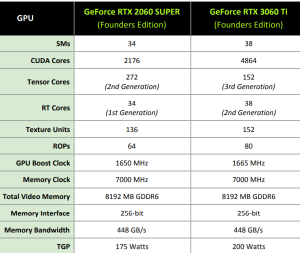-
The RTX 3060 Ti. Like other Nvidia 3000-series GPUs, it includes one HDMI 2.1 port and three DisplayPort 1.4 ports.
-
It comes with Nvidia's newfangled 12-pin connector, which works with a single 8-pin adapter for current PSUs.Nvidia
-
Another look at the top.Nvidia
-
Naked board.Nvidia
New computer GPUs have launched at a furious pace the past few months, mostly in the $500-and-up sector. This week, we finally see a 2020 GPU arriving at a lower price than a brand-new gaming console: the Nvidia RTX 3060 Ti, priced at $399 and launching tomorrow, December 2.
But once again this year, Nvidia is leaving people in the dark about how many of these cards we can expect to reach stores. We know the company manufactured at least one of them, at any rate, because my review hardware arrived last week. The usual gamut of benchmarks confirms performance on par with last year's RTX 2080 Super, at nearly half the cost.
Like other RTX-branded GPUs, the Nvidia RTX 3060 Ti features proprietary processing cores on its silicon—namely, its Tensor cores (for AI computation) and its RT cores (to manage all things ray tracing). To get to a $399 price, the 3060 Ti drops specs compared to its higher-ranked siblings in the usual categories, particularly CUDA cores, but it also severely drops its Tensor and RT core counts. Nvidia's trick here is that those core types have been updated since last year's model to do more work per core.
-
This entire gallery is made up of tests comparing the AMD RX 6800 ($579 MSRP), the RTX 3070 (MSRP $499), the RTX 3060 Ti (MSRP $399), and last year's RTX 2080 Super, as mildly overclocked using the EVGA X1 app.Ars Technica
-
Due to issues with my testing suite ahead of today's deadline, I couldn't go back and retest the apparent anomaly here with the RTX 3070. My apologies.Ars Technica
-
DLSS isn't available for AMD cards, so that option is always blank when applicable.Ars Technica
-
Some tests are missing RTX 2080 Super comparisons, due to some issues in my testing suite ahead of today's embargo lift.Ars Technica
-
The rest of the benchmarks generally show the RTX 2080 Super landing right next to the new RTX 3060 Ti.Ars Technica
-
Neck and neck at the bottom.Ars Technica
-
Not every Rockstar test result is equal...Ars Technica
-
... as the RTX 3060 Ti runs right past the 2080 Super.Ars Technica
-
Dead even at 4K.Ars Technica
-
Apologies, again, for the lack of 2080 Super comparison here.Ars Technica
If this were a market where you could easily snap up a $499 RTX 3070, some of these RTX 3060 test results would be hard to swallow, considering the price-per-dollar comparison. But there's no getting around this new card's ability to match the RTX 2080 Super (original MSRP: $699) in every category that counts.
Like most Ars Technica GPU reviews, we limit our benchmarks to 4K tests, owing to the fact that lower-resolution benchmarks typically become CPU-limited and thus don't tell the full story of how a GPU will turn out in your particular PC. (If you're wondering, my testing rig sports an i7-8700K CPU, overclocked to 4.7GHz, plus 32GB DDR4-3000 RAM, an 850W PSU, and a PCI-e 3.0 SSD.)

Otherwise, there's not a ton to say about RTX 3060 Ti that hasn't been spelled out with its costlier siblings. DLSS still impresses as a proprietary upsampling and anti-aliasing system, and that, combined with solid ray-tracing tech, continues to make Nvidia cards a tantalizing option—especially when clock speeds and CUDA cores have been reduced to hit the $399 sweet spot while still otherwise looking quite performative.
Meanwhile, if your favorite games don't tap into DLSS, you should expect to tinker with their settings to maximize their 1440p or 1080p performance levels—and I can't help but imagine AMD has a response to this exact use case with any future lower-priced RX 6000-series GPUs. But nothing of the sort has been announced yet, so for the time being, Nvidia takes the lead at this price point.
Listing image by Nvidia
reader comments
162